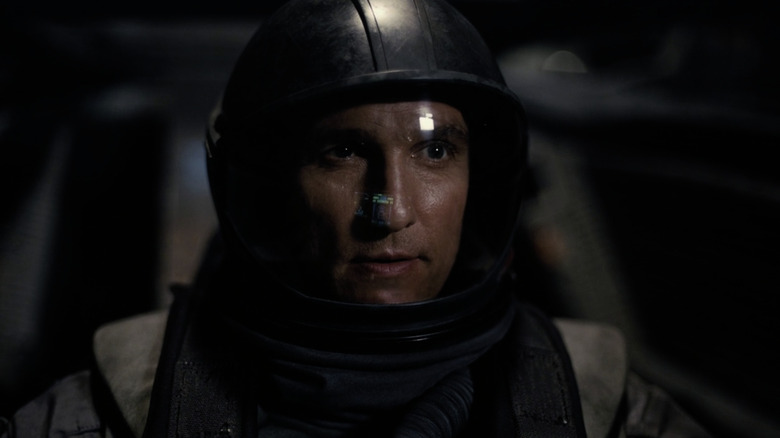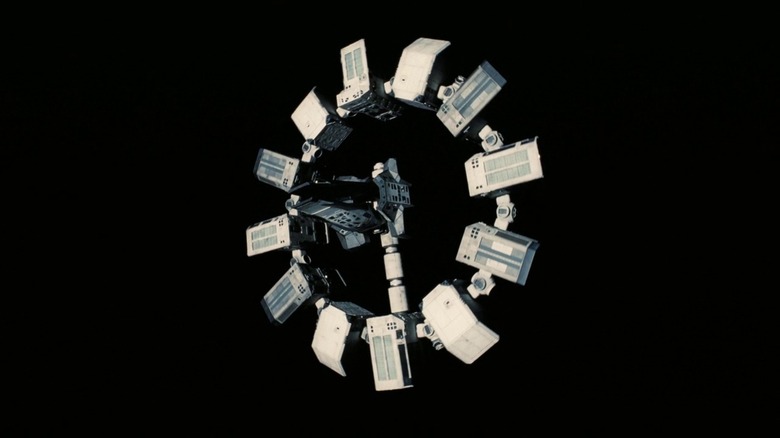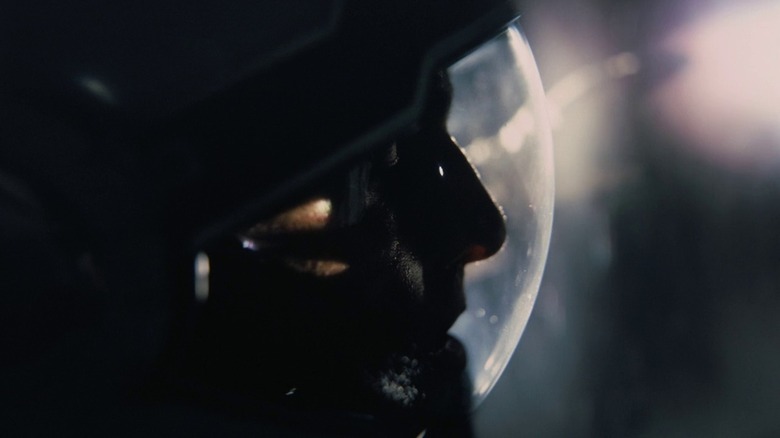Christopher Nolan Used A Tried-And-True Trick To Send Interstellar's Ships Into 'Space'
Christopher Nolan is one of the biggest filmmakers in modern Hollywood that makes enough returns on his blockbusters to actively preserve his old-fashioned filmmaking instincts. Going against the grain of current trends, he prides himself on his utilization of 70mm film, minimal usage of CGI, and his very firm stance that his films demand to be exhibited in a proper theatrical environment. It might seem a bit egotistical to some, but when one looks at his box office returns and critical praise, he's more than earned it. Unless you have the misfortune of being "Tenet," a new Nolan film is always a cinematic event; one that encourages your local theater to put aside their DCP files and whip out the 70mm projector for a limited amount of time.
Despite his devotion to capturing his spectacles in-camera, Nolan does utilize CG special effects work more often than you may think. The difference is that he uses CGI as a supplement to what he's capturing on set rather than depending on it. His most CGI heavy film, 2010's "Inception," required over 500 VFX shots for its dazzling dream world mirror scenes and geometrically "folding" buildings, but even those were a mixture of old-school camera tricks alongside the newer technology.
Oftentimes, Nolan's films can be guarded and emotionally distant, but "Interstellar" is one where the filmmaker wears his entire heart on his sleeve. For his most personal film in his filmography, Nolan aimed to authentically capture the feeling of outer space on set of the fictional ship, the Endurance. A 2014 Entertainment Weekly feature about the making of "Interstellar" revealed that the technique Nolan used to give the set the illusion of floating through space was actually a lot more antiquated than one would expect: It was achieved through the use of rear projection.
Rear projection is a classic Old Hollywood technique
Rear projection is a now-uncommon filmmaking technique that positions practical elements like sets and actors in the foreground of a shot, while the background elements are projected or screened. Older films frequently used rear projection to film dialogue scenes that happen within a car in order to give the illusion of movement without physically driving a car outside. One of the most famous and still pretty believable uses of rear projection was in Alfred Hitchcock's "North By Northwest," in which Cary Grant's character runs from a crop duster plane.
In "Interstellar," Nolan made sure that every window on his spaceship set would utilize rear projection, showing an endless swirl of stars, giving the spaceship set a feeling of authenticity. As the EW writer described:
"Walking up into the narrow interior — designed from galleys, jump seats, and control panels salvaged from junked airplanes — is like trying to keep your balance inside a mystery-shack tilt-house. Look through the small double-paned windows, and what you see, projected on a large black floor-to-ceiling curtain, is a vertiginous swirl of stars, which is exactly what you would see if you were inside an actual spacecraft swiftly spinning to generate 1g of gravity."
If you're familiar with filmmaking, you're probably wondering why Nolan didn't just opt for green screen. Rear projection offers something that green screen simply cannot: a sense of immersion. Projecting a key element allows the actors to have something to interact with and adds a feeling of physicality that is captured in-camera.
Rear projection lives on in The Volume
When you think about Nolan's commitment to realism, it's obvious why he would rather his actors stare at a projected video of supernovas rather than gaze into a green wall. "Another director would have hung bluescreens and then animated space in post production," the Entertainment Weekly feature notes, "Nolan, zealous about verisimilitude, loathes bluescreen the way the Amish loathe zippers."
While the more traditional approaches to rear projection have been largely phased out, the concept is still alive in modern blockbuster filmmaking through the form of digital soundstages, like ILM's The Volume which has been prominently utilized in projects like "The Mandalorian," "The Batman," and "Thor: Love and Thunder." The Volume is essentially one large wall of LED screens that can generate virtual sets. The utilization of this technology is quite controversial among film fans, but like any sort of filmmaking technique, good or bad filmmaking is not born from the tool itself, but rather the vision behind it.
Wielded responsibly, The Volume takes an old concept and breathes new life into it to open even more possibilities. Still, one can probably imagine that Nolan would still prefer to shoot something on location rather than use The Volume, since that's just the kind of filmmaker he is. However, even when it comes to his more outlandish and surreal film concepts, it's nice to know he's no stranger to tried and true camera tricks.


